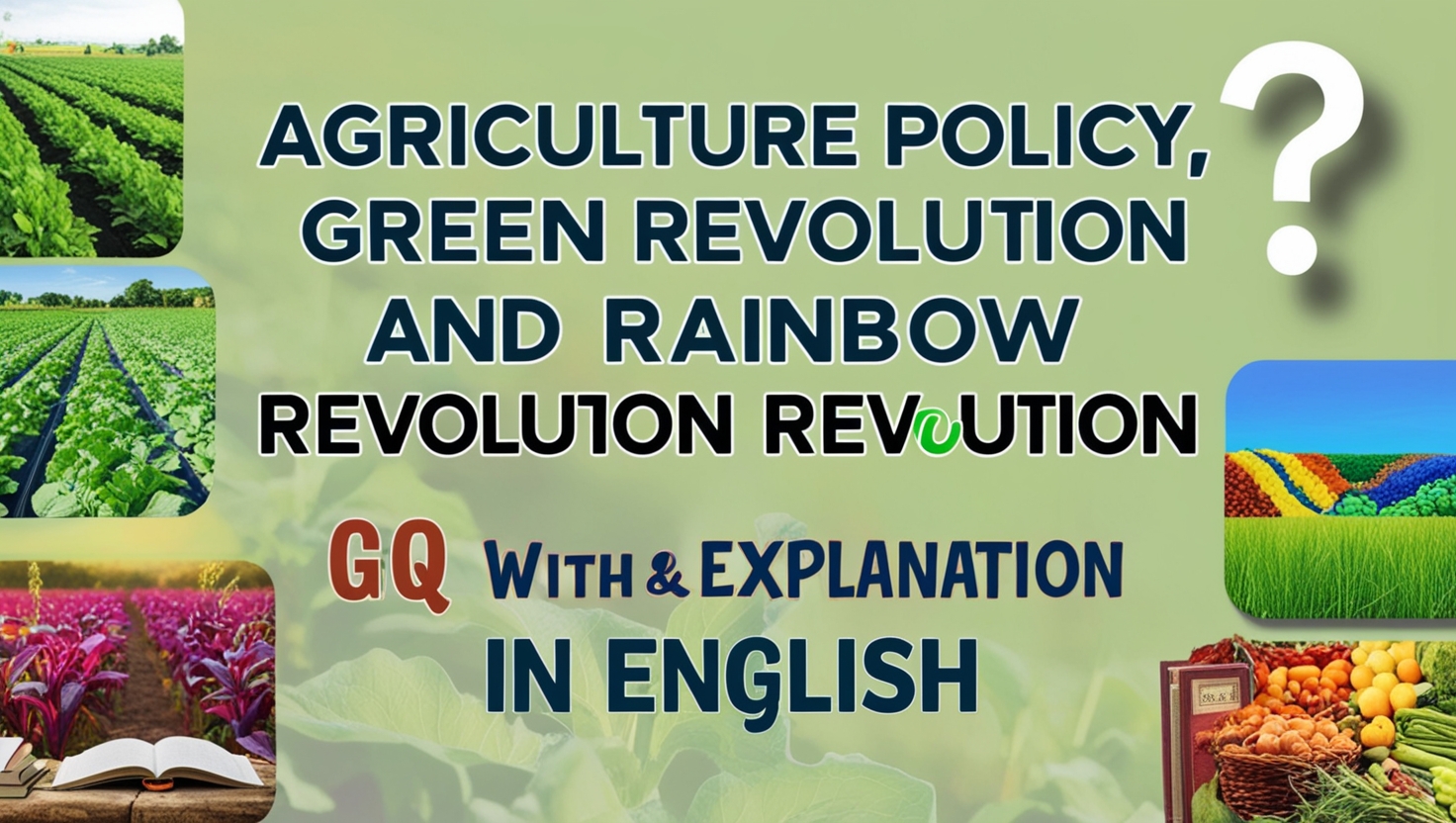
Agriculture policies, along with significant movements like the Green Revolution and Rainbow Revolution, have profoundly impacted food production and sustainability in India and around the world. This article, titled Agriculture Policy, Green Revolution and Rainbow Revolution GK MCQs With Answer & Explanation in English, presents a series of multiple-choice questions designed to test and enhance your understanding of these critical agricultural concepts.
Each question is accompanied by detailed answers and explanations, making this resource ideal for students, exam aspirants, and anyone interested in the evolution of agricultural practices. Explore these topics to gain deeper insights into how policies and revolutions have shaped modern agriculture.
1. Which of the following decides the Minimum Support Prices on behalf of the Government of India?
- Ministry of Agriculture
- Cabinet Committee on Economic Affairs
- Commission for Agricultural Costs & Prices
- None of Them
Show Answer
Answer: Commission for Agricultural Costs & Prices
The Commission for Agricultural Costs & Prices (CACP), functioning as an attached office of the Ministry of Agriculture and Farmers Welfare in India, recommends minimum support prices (MSPs) to encourage cultivators to adopt modern technology, enhance productivity, and boost overall grain production in alignment with the evolving demand patterns. The final approval for these MSPs comes from the Cabinet Committee on Economic Affairs (CCEA).
2. Which of the following bodies approves the Fair and Remunerative Price of Sugarcane?
- Cabinet Committee on Economic Affairs
- Commission for Agricultural Costs and Prices
- Directorate of Marketing and Inspection, Ministry of Agriculture
- Agricultural Produce Marketing Committee
Show Answer
Answer: Cabinet Committee on Economic Affairs
The Fair and Remunerative Price (FRP), the legally guaranteed minimum price for sugarcane farmers, receives approval from the Cabinet Committee on Economic Affairs (CCEA).
3. Who is known as the father of the green revolution in the world?
- Linus Pauling
- Ralph Bunche
- Norman Borlaug
- M.S. Swaminathan
Show Answer
Answer: Norman Borlaug
Norman Borlaug, hailed as the father of the green revolution, was an American agronomist who led global initiatives contributing to the significant increase in agricultural productivity.
4. Who is known as the father of the Indian green revolution?
- Verghese Kurien
- M.S. Swaminathan
- M.N. Roy
- P.C. Mahalanobis
Show Answer
Answer: M.S. Swaminathan
M.S. Swaminathan, recognized as the father of the Indian green revolution, is an Indian geneticist and administrator. His notable role in India’s Green Revolution involved the introduction of high-yield varieties of wheat and rice.
5. Which of the following oil seeds production was targeted under the yellow revolution?
1. Groundnut
2. Mustard
3. Soybean
4. Safflower
5. Sesame
Choose the right option:
- 1, 2 and 5
- 1, 2, 3 and 4
- 1, 2, 3, 4 and 5
- 1, 3, 4 and 5
Show Answer
Answer: 1, 2, 3, 4 and 5
The yellow revolution focused on nine oilseeds, including groundnut, mustard, soybean, safflower, sesame, sunflower, niger, linseed, and castor.
6. Where is the National Fisheries Development Board located?
- Pune
- Hyderabad
- Delhi
- Kolkata
Show Answer
Answer: Hyderabad
The National Fisheries Development Board (NFDB), headquartered in Hyderabad since its establishment in September 2006, works towards harnessing the untapped potential of the fisheries sector through fish culture, processing, marketing, and the application of modern research and development tools.
7. Where is the Central Institute of Freshwater Aquaculture (CIFA) located?
- Bhubaneswar
- Hyderabad
- Visakhapatnam
- Chennai
Show Answer
Answer: Bhubaneswar
The Central Institute of Freshwater Aquaculture (CIFA) in Bhubaneswar, Odisha, established in 1987 by the Indian Council of Agricultural Research (ICAR), is the country’s largest centre for inland aquaculture.
8. Who is known as the father of the golden revolution in India?
- Sam Pitroda
- Nirpakh Tutej
- PK Roy
- M.S. K. Kishore
Show Answer
Answer: Nirpakh Tutej
Nirpakh Tutej, known as the “Father of Golden Revolution,” played a crucial role in the significant increase in the production of fruits, honey, vegetables, and other horticulture products during this period. The Golden Revolution specifically focuses on advancements in honey and horticulture.
9. Which among the following is related to the silver revolution in the country?
- Production of Fish
- Production of Eggs
- Production of Cats
- Production of Prawns
Show Answer
Answer: Production of Eggs
The Silver Revolution is centered on the increased production of eggs, playing a vital role in ensuring the nutritional security of the country. Recognizing the significance of egg production contributes to addressing nutritional needs and fostering food security.
10. Which among the following is related to the green revolution?
- Use of Ground Water for Irrigation
- Growing More Types of Crops
- Increasing of Forests
- Use of High Yielding Variety of Seeds
Show Answer
Answer: Use of High Yielding Variety of Seeds
The Green Revolution in India is characterized by the adoption of high-yielding variety seeds (HYV seeds) and the integration of modern methods and technology to enhance agricultural practices. This agricultural transformation, starting with the introduction of HYV seeds for Wheat and Rice, aimed at boosting crop productivity and ultimately ensuring food security for the nation.







